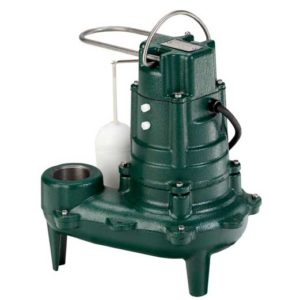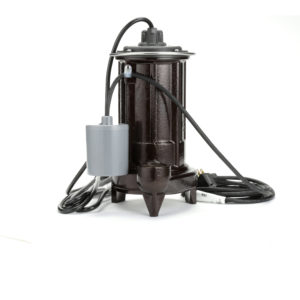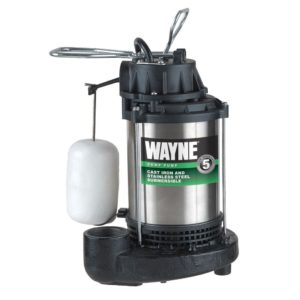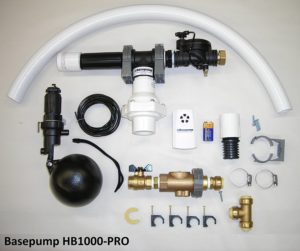
If you’ve already bought and installed a sump pump (both a primary and a backup), you’re ahead of the game when it comes to flood prevention. Even if you don’t have a backup, simply maintaining your primary sump pump can go a long way toward ensuring it’s ready to keep your basement dry when the rains start pouring and the water starts rising.
However, many homeowners, business owners, and landlords shy away from sump pump repairs and maintenance out of a lack of knowledge and fear of making things worse. Fortunately, you don’t have to join a trade union to learn some basic plumbing. Today we’ll cover some of the more common areas to look over and how to fix them if something goes awry in your sump pump setup.
Make sure the float is in good working order

One of the most important parts of any sump pump is its float. Unfortunately, it’s also one of the parts most prone to failure. A float is, as its name suggests, a piece of your pump that floats, or rises, in your sump pit whenever water levels rise. When it reaches a certain level, your sump pump motor activates and begins to pump water out of the sump basin and out of your home via a discharge pipe.
Conversely, when enough water has been pumped out or when the water level has naturally dropped, so does the float, and the pump is triggered to turn off. It’s the same technology that starts and stops a toilet tank from filling with water. If it doesn’t work, however, your pump won’t start pumping when it needs to, and you’ll have a flooded basement on your hands. This is why testing it on a regular basis (we suggest every three months or so) is a good idea.
You can check it easily by running a garden hose into your sump pit or by slowly pouring water inside it via a bucket. You should see your float rise with water levels, resulting in the activation of your pump, the removal of water, the lowering of the float, and the turning off of your pump. A pump that doesn’t shut off due to a stuck or malfunctioning float is almost as bad as a pump that doesn’t start for the same reason: the pump will eventually burn out, leaving you with nothing to defend your basement unless you have a backup sump pump.
It’s worth noting that a water-based sump pump doesn’t use a float switch, meaning you can ignore the information above and rest easy if you have one. However, if you use both an electricity- and water-based pump in the same pit, you’ll still need to check the float for the electric pump.
Clean out your sump basin (the sump pit)
Just as you wouldn’t throw garbage in your sink and wonder why your drains stopped working, your sump pit needs to be clean if you want your sump pump to do its job. To put it simply, you need to keep your sump pit as free of debris as possible to keep your float free to rise and fall with water levels.
Even the best AC pump on the market (e.g., the Zoeller M267) won’t be able to keep up with water levels if the float gets stuck. Keep your pit clear and check it every few months to make sure it stays that way. You don’t need any special tools besides some gloves, a plastic bag, and a willingness to get a little dirty; the most you’re likely to find there is dirt, mud, gravel, stones, and leaves.
Make sure the check valve isn’t faulty

The check valve serves the same function as the little flap in our throats that closes when we drink so water doesn’t enter our lungs; it makes sure fluids go one way and not the other. In this case, it keeps water moving up and out of the pit via the discharge pipe. If it fails, your pump will run whenever the float switch tells it to, but it’s never going to remove water from your sump pit, because it’s just going to rush back down the gravity tube and re-enter the pit through your intake pipe.
You can test this by the garden hose and bucket methods above. If your pump is running but water isn’t leaving, it’s probably the check valve that’s giving you trouble, and it will need replacement.
If there’s an impeller, clean it

If you’re dealing with an electricity-powered sump pump, it’s going to have an impeller to pump water from the intake pipe to the discharge pipe and out of your home. The impeller will be located inside the pump and typically behind some kind of screen that helps keep debris out–the debris you’re ideally cleaning frequently from your sump pit. However, if enough debris gets past or through the screen, your impeller can jam. If it jams, your pump won’t pump a thing until the impeller is unjammed.
To check if this is an issue, do the garden hose or bucket test. if your pump isn’t running and is connected to a working power source, you’ll want to unplug it, detach the intake and discharge pipes, and pull the pump from your sump basin. You’ll need to open up the pump to get past the screen and clear debris from the impeller, and then close everything back up and reconnect the pump. This is a procedure many homeowners won’t be comfortable with, so you might want to call for help from a plumber here if you don’t want to tackle it on your own. However, if you can do so on your own, you can save a lot of money and fix what’s essentially a very simple problem.
Once again, this is a problem unique to electricity-powered pumps. If you’re using a water-based pump, none of this applies to you.
Verify your electrical connections
Finally, if you’re using a motor-driven pump, you’ll want to make sure everything is plugged in if the pump doesn’t seem to be working. That means checking the pump-to-cord connection, the plug at the outlet, and your circuit breaker. If you have a ground fault circuit interrupter, or GCFI, make sure that hasn’t been tripped, as sump pumps are notorious for activating them. You’ll be back on your way once you press the reset button. However, if your electrical supply is connected and in good working condition (use a plug-in phone charger or similar small device to test your outlets), the pump itself is likely in need of repair.
Invest in a reliable AC, backup, or water-powered sump pump

By now, we’ve hopefully established that having a quality sump pump is the first part of the maintenance chain; just as with cars, every vehicle looks nice when it rolls off the lot, but the engineering at the factory will determine whether you’re desperate to sell it at 100,000 miles or if you’re simply getting ready for another 100,000 on the odometer. It’s worth starting out with a machine that costs a bit more but lasts a lot longer than trying to save a bit now only to pay a lot more later.
If you’re going to buy an AC pump, make it a Zoeller M267, which we’ve reviewed here and sung the praises of for years. If you want a DC backup, get the Wayne WSM3300, which we’ve reviewed here, and rest easy. For a combination AC/DC pump, buy the Wayne WSSM40V, which we’ve reviewed here and continue to be impressed by. And if you’re tired of depending on electricity, forget everything above and invest in a water-based sump pump like the Basepump HB1000-PRO, which we’ve reviewed here, and would trust to keep any home of ours dry.
 If you find our work at PumpThatSump helpful, you can put our relentless reviewing of every pump and fixture on the market to the test by shopping via our links above for whatever you need to make your house a home. Despite being self-employed, we promise not to spend it all on health insurance.
If you find our work at PumpThatSump helpful, you can put our relentless reviewing of every pump and fixture on the market to the test by shopping via our links above for whatever you need to make your house a home. Despite being self-employed, we promise not to spend it all on health insurance.
